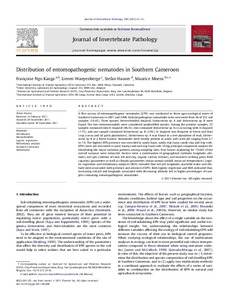| dc.contributor.author | Ngo Kanga, F. |
| dc.contributor.author | Waeyenberge, L. |
| dc.contributor.author | Hauser, S. |
| dc.contributor.author | Moens, M. |
| dc.date.accessioned | 2019-12-04T11:04:21Z |
| dc.date.available | 2019-12-04T11:04:21Z |
| dc.date.issued | 2012-01 |
| dc.identifier.citation | Ngo Kanga, F., Waeyenberge, L., Hauser, S. & Moens, M. (2012). Distribution of entomopathogenic nematodes in Southern Cameroon. Journal of Invertebrate Pathology, 109(1), 41-51. |
| dc.identifier.issn | 0022-2011 |
| dc.identifier.uri | https://hdl.handle.net/20.500.12478/1405 |
| dc.description.abstract | A first survey of entomopathogenic nematodes (EPN) was conducted in three agro-ecological zones of Southern Cameroon in 2007 and 2008. Entomopathogenic nematodes were recovered from 26 of 251 soil samples (10.4%). Three species, Heterorhabditis baujardi, Steinernema sp. A and Steinernema sp. B were found. The two steinernematids were considered unidentified species. Among the positive samples, 23 samples contained only H. baujardi (88.5%), two contained Steinernema sp. A co-occurring with H. baujardi (7.7%), and one sample contained Steinernema sp. B (3.9%). H. baujardi was frequent in forest and fruit crop (cocoa and oil palm plantations). Steinernema sp. A was found in a tree plantation of teak, Steinernema sp. B in a forest habitat. Nematodes were mostly present in acidic soils with pH ranging from 3.7 to 7.0. The highest EPN presence was recorded in sandy loam, sandy clay loam, sandy clay and clay soils. EPNs were not recovered in sand, loamy sand and clay loam soils. Using principal component analysis for elucidating the major variation patterns among sampling sites, four factors explaining for 73.64% of the overall variance were extracted. Factors were a combination of geographical (latitude, longitude, altitude), soil (pH, contents of sand, silt and clay, organic carbon, texture), and moisture (wilting point, field capacity) parameters as well as climatic parameters (mean annual rainfall, mean air temperature). Logistic regression and redundancy analyses (RDA) revealed that soil pH, longitude, available water and altitude were associated with presence and absence of EPN. Both logistic regression and RDA indicated that, increasing soil pH and longitude, associated with decreasing altitude, led to higher percentages of samples containing entomopathogenic nematodes. |
| dc.description.sponsorship | Vlaamse Interuniversitaire Raad |
| dc.format.extent | 41-51 |
| dc.language.iso | en |
| dc.subject | Entomopathogenic Nematodes |
| dc.subject | Plantations |
| dc.title | Distribution of entomopathogenic nematodes in Southern Cameroon |
| dc.type | Journal Article |
| dc.description.version | Peer Review |
| cg.contributor.affiliation | International Institute of Tropical Agriculture |
| cg.contributor.affiliation | Ghent University |
| cg.contributor.affiliation | Institute for Agricultural and Fisheries Research, Belgium |
| cg.coverage.region | Africa |
| cg.coverage.region | West Africa |
| cg.coverage.country | Cameroon |
| cg.isijournal | ISI Journal |
| cg.authorship.types | CGIAR and advanced research institute |
| cg.iitasubject | Plant Disease |
| cg.iitasubject | Disease Control |
| cg.journal | Journal of Invertebrate Pathology |
| cg.howpublished | Formally Published |
| cg.accessibilitystatus | Limited Access |
| local.dspaceid | 79546 |
| cg.identifier.doi | https://dx.doi.org/10.1016/j.jip.2011.09.008 |

